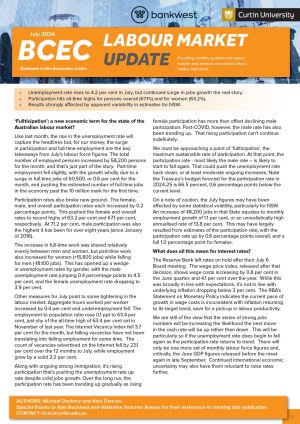BCEC Monthly Labour Market Update – July 2024
— Unemployment rate rises to 4.2 per cent in July, but continued surge in jobs growth the real story. —
— Participation hits all-time highs for persons overall (67.1%) and for women (63.2%). —
— Results strongly affected by apparent variability in estimates for NSW. —
‘Fullticipation’: a new economic term for the state of the Australian labour market?
Like last month, the rise in the unemployment rate will capture the headlines but, for our money, the surge in participation and full-time employment are the key takeaways from July’s labour force figures. The total number of employed persons increased by 58,200 persons for the month, and that’s just part of the story. Part-time employment fell slightly, with the growth wholly due to a surge in full-time jobs of 60,500, or 0.6 per cent for the month, and pushing the estimated number of full-time jobs in the economy past the 10 million mark for the first time.
Participation rates also broke new ground. The female, male, and overall participation rates each increased by 0.2 percentage points. This pushed the female and overall rates to record highs of 63.2 per cent and 67.1 per cent, respectively. At 71.2 per cent, male participation was also the highest it has been for over eight years (since January of 2016).
The increase in full-time work was shared relatively evenly between men and women, but part-time work also increased for women (+15,800 jobs) while falling for men (-18.100 jobs). This has opened up a wedge in unemployment rates by gender, with the male unemployment rate jumping 0.4 percentage points to 4.5 per cent, and the female unemployment rate dropping to 3.9 per cent.
Other measures for July point to some tightening in the labour market. Aggregate hours worked increased by 0.4 per cent and underemployment fell. The employment to population ratio rose 0.1 ppt to 64.3 per cent, just shy of the all-time high of 64.4 per cent set in November of last year. The Internet Vacancy Index fell 3.7 per cent for the month, but falling vacancies have not been translating into falling employment for some time. The count of vacancies advertised on the Internet fell by 23.1 per cent over the 12 months to July, while employment grew by a solid 3.2 per cent.
Along with ongoing strong immigration, it’s rising participation that’s pushing the unemployment rate up despite solid jobs growth. Over the long run, the participation rate has been trending up gradually as rising female participation has more than offset declining male participation. Post-COVID, however, the male rate has also been trending up. That rising participation can’t continue indefinitely.
We must be approaching a point of ‘fullticipation’, the maximum sustainable rate of participation. At that point, the participation rate – most likely the male rate – is likely to start to fall again. That could push the unemployment rate back down, or at least moderate ongoing increases. Note the Treasury’s budget forecast for the participation rate in 2024-25 is 66.5 percent, 0.6 percentage points below the current level.
On a note of caution, the July figures may have been affected by some statistical volatility, particularly for NSW. An increase of 48,200 jobs in that State equates to monthly employment growth of 1.1 per cent, or an unrealistically high annualised rate of 13.8 per cent. This may have largely resulted from estimates of the participation rate, with the participation rate up by 0.6 percentage points overall, and a full 1.0 percentage point for females.
What does all this mean for interest rates?
The Reserve Bank left rates on hold after their July 6 Board meeting. The wage price index, released after that decision, shows wage costs increasing by 0.8 per cent in the June quarter, and 4.1 per cent over the year. While this was broadly in line with expectations, it’s not in line with underlying inflation dropping below 3 per cent. The RBA’s Statement on Monetary Policy indicates the current pace of growth in wage costs is inconsistent with inflation returning to its target band, save for a pick-up in labour productivity.
We are still of the view that the series of strong jobs numbers will be increasing the likelihood the next move in the cash rate will be up rather than down. This will be particularly so if the unemployment rate does begin to fall again as the participation rate returns to trend. There will only be one more set of monthly labour force figures and, critically, the June GDP figures released before they meet again in late September. Continued international economic uncertainty may also have them reluctant to raise rates further.



